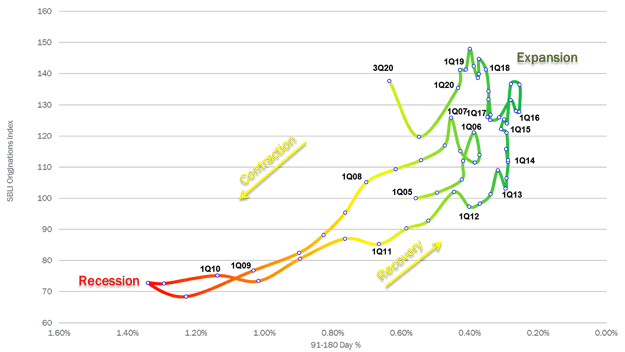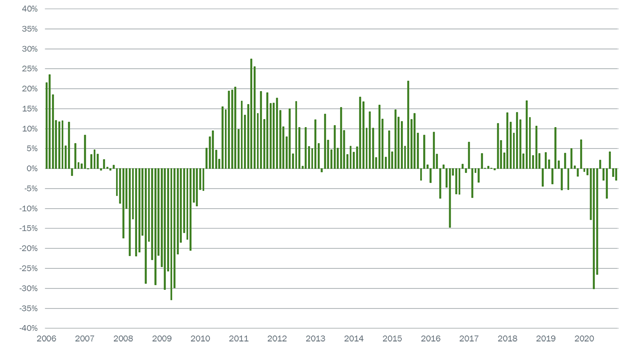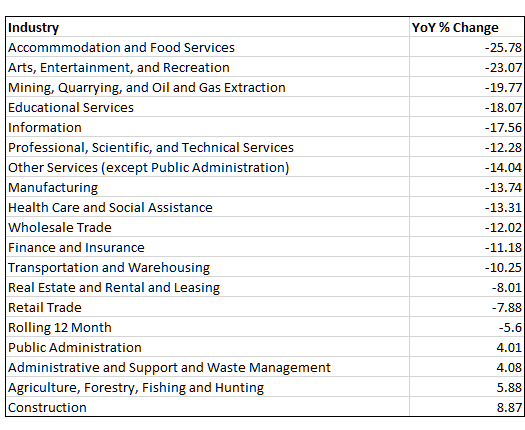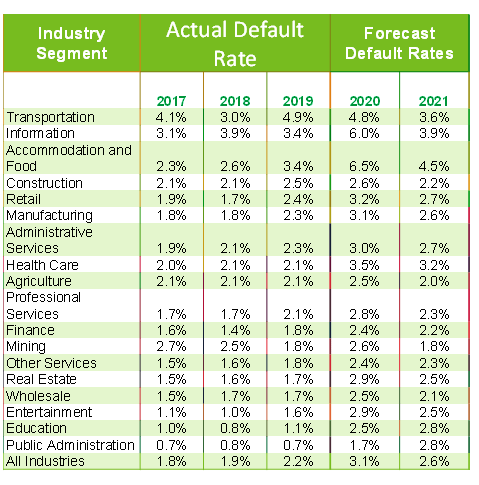Digital Main Street
Equifax Commercial’s latest report on Main Street financial health and investment requires suspending traditional views on capital and finance during normal economic conditions. As Dorothy said in the “Wizard of Oz,” – “We’re not in Kansas anymore.” Historically low interest rates, massive government stimulus, accelerated digitization, political turmoil and pandemic adaptation create a new fact pattern that is not easy to place into the next economic paradigm. This latest release of the indices shows Main Street on a stimulus high from government grants and low cost of capital that good while it lasts, risks crashing into a future of higher capital and technology costs.
Business Cycle
Analysis of the business cycle reveals rapid and material recovery of private companies over the last quarter. Figure 1 shows investment in Q1 rose versus the prior quarter while credit risk ticked higher yet again as it has in each of the last six quarters. The rapid growth in investment shows private companies reacting to the business shifts required of a post-pandemic world. Private companies are likely adjusting in areas such as digitization, new hygiene standards and new distribution systems. At the same time, financial risk has increased from the historical lows pre-pandemic. These higher rates of financial risk likely reflect a more normalized view of credit risk among private business. Even so, the massive stimulus programs continue to mask actual risks. Stimulus has provided private companies the confidence to stay invested. Transitioning to a post-stimulus economy will be a challenge.

Figure 1: Equifax Small Business Cycle
Recent Investment Activity
In November, the Equifax Small Business Lending Index (SBLI) fell 9 points (-6.2 percent) to 136.7, down 2.4 percent compared to November of last year. The SBLI three-month moving average increased 1.1 percent to 142.7 and is now just 0.1 percent below its year-ago level, nearly returning to its pre-pandemic level.

Figure 2: Equifax Small Business Lending Index
As a result, the SBLI has nearly recovered all of the losses resulting from the pandemic.

Figure 3: Equifax Small Business Lending Index Year-over-year change, January 2006–November 2020
One of the particularly notable observations of small businesses during the pandemic remains the uneven performance of industry groups. Some are thriving while others are in their worst recession ever. Industry groups remain the definition of a tale of two cities.

Figure 4: Equifax Small Business Lending Index
Industry Story: In November, lending activity declined in 15 of 19 industries. The largest annual decrease occurred in Accommodation & Food (-25.8 percent), Mining, Quarrying, Oil & Gas (-19.8 percent), and Professional Services (-14.3 percent). Manufacturing (-13.7 percent), Health Care (-13.3 percent) and Transportation (-10.3 percent) standout as other large sectors showing major declines in business spending. Public Administration (+4.0 percent), Administrative Services (+4.1 percent), Agriculture (+5.9 percent) and Construction (+8.9 percent) show the only increases among industry sectors.
Regional Story: Lending activity weakened in eight of the 10 largest states in November including Michigan (-2.7 percent M/M), New York (-1.5 percent M/M), Florida (-0.9 percent M/M), and Pennsylvania (-0.9 percent M/M). Meanwhile, lending ticked up in Georgia (+1.1 percent M/M) and North Carolina (+0.4 percent M/M). On a year-on-year basis, lending remains down in all 10 of the largest states, with the largest declines having occurred in Texas (-7.9 percent Y/Y), Pennsylvania (-12.3 percent Y/Y) and New York (-13.6 percent Y/Y). Despite the decline in the headline index, the three-month moving average reached its highest point since the beginning of the pandemic.
Credit Risk
The Equifax Small Business Delinquency Index (SBDI) 31–90 Days Past Due inched up 1 basis point (bp) in November, the first monthly increase since May, and is 7bp above its November 2019 level. The SBDI 91–180 Days Past Due was unchanged and 19bp above its year-ago level. Defaults fell 4 bp to 3.24 percent, the first decline in more than two years
Industry Story: Two of the six tracked industries saw delinquencies rise in November as financial stress ticked up in Construction (+8bp M/M) and Retail (+3bp M/M); meanwhile, Health Care (-10bp M/M) experienced another decline. Compared to a year ago, Construction (-40bp Y/Y) and Transportation (-71bp Y/Y) are on better footing, while delinquency levels remain elevated in Retail (+64bp Y/Y) and Health Care (+32bp Y/Y). Regarding defaults, 11 of 18 industries experienced declining rates last month, including Transportation (-35bp M/M), Finance (-8bp M/M), and Real Estate (-10bp M/M). However, since November of last year, defaults remain high in Accommodations (+345bp Y/Y), Information (+243bp Y/Y), and Health (+163bp Y/Y).
Regional Story: In November, delinquencies rose in seven of the ten largest states — the first time they have risen in any of the tracked states since June — with sizable increases in Florida (+9bp M/M; -18bp Y/Y), Illinois (+13bp M/M; +55bp Y/Y) and Georgia (+15bp M/M; +20bp Y/Y). Delinquencies ticked down in Michigan (-3bp M/M; +12bp Y/Y) and New York (-3bp M/M; +12bp Y/Y). In contrast, defaults rose in just two states (Georgia, +8bp M/M; and Ohio, +2bp M/M), while notable declines were seen in Texas (-14bp M/M) and Michigan (-8bp M/M). On a year-on-year basis however, defaults remain elevated in all 10of the largest states.

Figure 5: Equifax Small Business Delinquency & Default Indices
Given the extraordinary business disruptions arising from the pandemic, the 1 basis point rise in credit risk last month is a win. The stimulus programs have enabled small business to recover as seen through the improvement in 31+ days past due by over 70 basis points since May. With additional stimulus programs underway, credit risk will likely remain moderate if not improve over the next several months. If stimulus programs don’t materialize, small businesses in industry sectors hardest hit by the pandemic will likely exhibit increased delinquencies.
Credit Risk Outlook
The uncertainty brought on by the pandemic shows in the rapid increase in defaults in 2020. However, because of improved business conditions for private companies, we are forecasting defaults to fall in 2021.

Figure 6: Equifax Forecast Default Rates
Defaults jumped in key industry sectors such as Transportation, Retail, Accommodation & Food, and Manufacturing, which make up large sectors of the private economy. But with recent improvements in macro-economic conditions combined with added government stimulus programs, we are forecasting lower defaults for 2021 in these and several other sectors..
Summary
While current business conditions remain unsettling for private companies, what we can say from this release and the results of Q1 is that stimulus has propped up private companies and helped them get through the pandemic with greater confidence than during past recessions. But the deeper trend underway is forcing small businesses to turn digital. The next generation of small businesses will shift and reform unlike anything we’ve seen in the past. Current conditions mask this reality and likely mean that financial risk remains at artificially low levels and investment rates are masked, difficult to fully understand and will take several quarters to fully play out. We can say that the Outlook for 2021 contains more stimulus, accelerated digitization, return to opportunity (marketing) and winners and losers determined in part by industry segments.